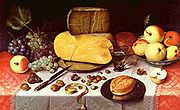- Full course dinner
-
Part of a series on Meals 
Common meals Breakfast · Brunch · Lunch · Tea · Dinner · Supper Components & courses Amuse-bouche · Appetizer · Cheese · Cocktails · Dessert · Drink · Entrée · Entremet · Fruit · Main course · Nuts · Salad · Side dish Related concepts Banquet · Buffet · Cuisine · Eating · Etiquette · Food · Global cuisines · Outline of cuisines · Snack A full course dinner is a dinner consisting of multiple dishes, or courses. In its simplest form, it can consist of three or four courses, such as soup, salad, meat and dessert.
Contents
Form
In formal dining, a full course dinner can consist of five, seven, eight, ten or twelve courses, and, in its extreme form, has been known to have twenty-one courses. In these more formalized dining events, the courses are carefully planned to complement each other gastronomically. The courses are smaller and spread out over a long evening, up to three, four or five hours, and follow conventions of menu planning that have been established over many years.
Most courses (excluding some light courses such as sorbets) in the most formal full course dinners are usually accompanied by ("paired with") a different wine, liqueur, or other spirit; today, craft beers and sakes are increasingly being integrated into the pairings.
Cutlery
Table settings can be elaborate. More ostentatious settings sometimes include all silverware and glassware that will be needed for the entire meal, and lay out the silverware so that the outermost tools are used for the dishes appearing earliest on the menu. In this scheme, when diners are served the first course, they can depend on finding the correct implement at the outermost edge of the arrangement.
An alternative scheme arranges the place setting so that only the implements needed for the first one or two courses appear in the table setting. As the dinner progresses and new courses arrive, used implements are removed with the dishes, and new silverware is placed next to the plates. Generally speaking, at a formal dinner implements are not used for more than one course. This scheme is commonly used when dinners are offered à la carte, so that the most appropriate implement is selected for a given course. For example, some diners may order clear, thin soups and others may order thick, creamy soups. As each of these soups has its own unique spoon, it would be considered improper and impractical to lay out a spoon that may not be needed or correct.
Example meal
The first class passengers aboard the ill-fated ocean liner Titanic were served a ten course meal[1] :
First Course
- Hors D'Oeuvres
- Oysters
Second Course
- Consommé Olga
- Cream of Barley
Third Course
- Poached Salmon with Mousseline Sauce, Cucumbers
Fourth Course
- Filet Mignons Lili
- Saute of Chicken, Lyonnaise
- Vegetable Marrow Farci
Fifth Course
- Lamb, Mint Sauce
- Roast Duckling, Apple Sauce
- Sirloin of Beef, Chateau Potatoes
- Green Pea
- Creamed Carrots
- Boiled Rice
- Parmentier & Boiled New Potatoes
Sixth Course
- Punch Romaine
Seventh Course
- Roast Squab & Cress
Eighth Course
- Cold Asparagus Vinaigrette
Ninth Course
- Pate de Foie Gras
- Celery
Tenth Course
- Waldorf Pudding
- Peaches in Chartreuse Jelly
- Chocolate & Vanilla Eclairs
- French Ice Cream
An example[citation needed] of a twenty-one course dinner follows:- Palate cleanser, or amuse. This may be preceded by a refreshing, lightly alcoholic drink, if the diners are to wait or mingle before being seated.
- Second amuse
- Caviar
- Cold appetizer
- Thick soup
- Thin soup
- Shellfish
- Antipasto
- Pasta (usually short, long pasta being more suited to informal lunches)
- Intermezzo (Sorbet)
- Quail
- Wild mushrooms
- Beef
- Green salad
- Puffed pastry filled with herbed mousse
- Cheese
- Pudding
- Ice cream
- Nuts
- Petit four
- Coffee, liquor (in a home, as opposed to a restaurant, these are properly served in the more relaxed setting of a drawing room or salon, not at the dining table)
Courses such as the above need not be served in strict sequence. Many are well-suited to be served paired with the previous or next course; this also minimises waiting for guests who may choose to have very little of a course for one reason or another.
See also
Categories:- Meals
Wikimedia Foundation. 2010.
